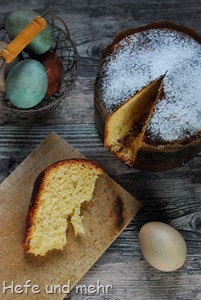 Sometimes you stumble over a recipe and then it catches you so much, that you change all your plans just to bake it. For me this happend when I read about the Schiacciata di Pasqua, the Tuscan Easter bread similar to Panettone. It is baked with olive oil, what tempted me very much. And because I was feeding my sweet starter anyway to bake a Colomba pasquale I decided to make to festive breads for Eastern in parallel.
Sometimes you stumble over a recipe and then it catches you so much, that you change all your plans just to bake it. For me this happend when I read about the Schiacciata di Pasqua, the Tuscan Easter bread similar to Panettone. It is baked with olive oil, what tempted me very much. And because I was feeding my sweet starter anyway to bake a Colomba pasquale I decided to make to festive breads for Eastern in parallel.
For my recipe I checked many formula available in the net but had to realize that the amount of olive oil varies a lot. At the end I placed my recipe somewhere in the middle. A little change to the original formula is that I avoided to add anise seeds which I do not like at all. But I added them in the recipe in brackets, because the traditional Schiacciata di pasqua has to contain these seeds.
It is a very delicious bread in the end, sweet with a subtle hint of olive oil and very slight sourness from the sourdough. The crumb can be teared into long fibers and is very light. A perfect gift for the family on Easter Morning!
Schiacciata di Pasqua
yields 2 Bread
- 60g Sweet Starter (freshly made or at 2-3 time refreshed the day before)
- 60g flour Type 550
- 30g water
First sdough
- 100g flour Type 550
- 35g Water
- 60g Egg
- 45g sugar
- 150g Sweet Starter
Second dough
- 60g flour Type 550
- 30g Egg
- 20g sugar
- 10g olive oil
- first flour
Third Dough
- second dough
- 260g flour Type 550
- 5g Salt
- Seeds of 1/2 vanilla bean
- grated peel of 1 Orange
- 90g Egg
- 80g sugar
- 60g olive oil
- 50g Butter
- (10g Anise seeds (if you like that))
- 50g Vin Santo
Glazing
- 1 swirled Egg
accessories
- 2 Paper Panetonne molds
(Soak anise seeds in vin santo)
Mix all ingredients for the Sweet starter and let it rise for 2-3 hours at 30°C until the volume doubled.
First dough: Mix all ingredients to form a homogenous dough. Ferment for 1.5-2 hours at 30°C until the volume doubled.
Second dough: Mix first dough with the other ingredients for the third dough and ferment it for 1.5-3 hours at 30°C until the volume doubled.
Third dough: In a stand mixer mix the third dough with flour, egg, spices, vin santo (with or without anise seeds), salt and eggs and knead for 5 min at slow speed. Knead another 5 min at fast speed The dough is very stiff at this time.
Now add 20g sugar and mix on slow speed for one minute.
Add 15g oil and mix in slow speed for one minute.
Add 20g sugar and continue mixing for one minute.
Add now oil and sugar like before until all sugar and oil is incorporated.
Now add the butter and knead until the butter is fully incooperated (about 2 min).
Continue mixing on medium speed until full gluten development (about 7-10 min).
Ferment for 3 hours at room temperature. The volume should double in this time.
Now grease the counter and your hands very well with butter to prevent the dough to stick. Divide the dough into 2 equal parts (about 500g) and shape into balls. Place in the paper mold.
Proof for 10– 20 hours until it reach the top of the mold(Proofing time depends on room temperature and strength o f the starter, if it rise very slowly, put them on a warm spot witu 26°C-30°C).
Prior to baking glaze with egg.
Bake at 160°C for 40 min with steam.
Deutsch



I was looking for Easter bake with starter. On other hand I’m not big fan of this type of bread-cake sweets. I was more after tradition rather taste. It turned out insanely good. So nice sweetness with a bit of sourness. I’ll definitely bake this for my family on Easter holidays.
@Rima: I’m glad you liked it 😀
Hallo Stefanie,
ich habe dieses Rezept ausprobiert! Ich habe den süßen Starter angesetzt und alles nach Rezept verarbeitet und ich muss sagen: OHH MEIN GOTTTTTT…es ist herrlich! vollkommen…und wie das Brot aufgegangen ist ohne Hefe. Meine Familie und ich haben eben die ersten Stücke vernasch….wahnsinn!
@Alessadra: Die Triebkraft fasziniert mich auch immer wieder 🙂
Hallo Stefanie,
da ich bis jetzt noch keinen süßen Starter habe, könnte ich auch eine Biga verwenden?
Liebe Grüße
Rebecca
@Rebecca: Das kannst du machen. Ich würde dann aber dem Teig nochmal 2g Hefe zusetzen.
Hallo Stefanie,
würdest du die Hefe erst beim Hauptteig beigeben oder gleich beim ersten Teig?
Liebe Grüße
Rebecca
@Rebecca: Ich würde die Hefe zum Hauptteig hinzugeben.
hallo,
hüpf hüpf ich wollte hier mal den Küchenplausch Osterhasen da lassen und dich zu unserem Oster Event einladen.
Du findest das Event hier: http://www.kuechenplausch.de/events/cmviews/id/301
Ich würde mich sehr freuen, wenn du mit deinem Rezept daran teilnimmst. Es gibt auch wieder was tolles zu gewinnen. 🙂
Liebe Grüße
Isabell
Hmm, schönes Rezept! Schade, dass Ostern schon rum ist – aber für nächstes Jahr ist das Rezept gespeichert!
LG,
Susanna
@Susanna: Ja, das ist der Haken, wenn ich verblogge, was ich an Ostern serviere 😉 Darum mache ich vor Ostern immer meine Ideen-Sammlung, um an die Rezepte zu erinnern, die ich im Vorjahr zu Ostern gebacken habe (ist auch für mich hilfreich)!